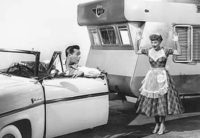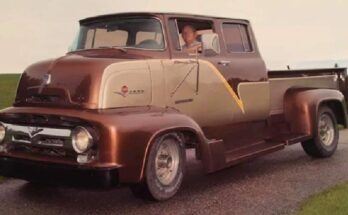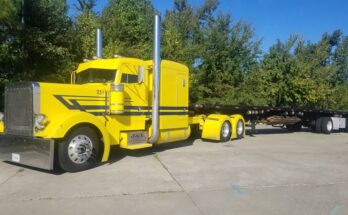For anyone who does not think the movies are an influential part of just about everyone’s life, consider “The Long, Long Trailer.” Never heard of it, you say?
Maybe you have heard of “I Love Lucy?”
No?
Also from the 1950s but also still seen in TV re-runs,
To stop the suspense, we are referring here to Lucille Ball and Desi Arnez who at one time were among the world’s most famous couples.
They were also the stars of the TV program and that the world’s most famous trailer movie.
The trailer itself was a star: New Moon made it. The Michigan-based company said it was the world’s largest. It was as much the star at Lucy and Desi in the “Long Trailer” film that portrayed the mishaps of the pair.
As you might imagine, many of the movie mishaps involved the long trailer crashing into just about everything. The main loser: homes.
This was the 1950s, when the so-called “Wheel estate market boasted many bold designs,” as writer Juergen Eichermueller put it in a story of that time that had the title: “When Wheel Estate Went Wild.”
What he was referring to…
“The travel trailer, or mobile home (as they were more commonly called), could be moved, usually by a special moving company, at the whim of the owner. Whereas the stick-built homeowner was tied down, literally, to the property on which their house was built, the mobile homeowner could ‘get up and go’ to any part of the country, and in any season.”
Of course, when Lucy and husband moved it via a 1953 Mercury convertible, it was comedic mayhem.
The popularity of trailers in these relatively early days was powered by Lucy, you might say.
“TV stars Lucille Ball and Desi Arnaz brought respectability, fanfare, and a surge of sales to trailers and their industry with the 1954 comedy film ‘The Long, Long Trailer,’ “ according to one report.
The couple’s adventures were centered around their new vacation home on wheels—a streamlined, yellow-and-white, 36-foot 1953 New Moon version.
The film changed attitudes. Including the thought that trailer folks were cheap.
As the writer put it:
“The excitement that surrounded the ‘I love Lucy’ trailer was the best thing that could have happened to any trailer manufacturer in the 1950s. What’s more, trailer folks (as well as parks) were portrayed as nice and pleasant—never as ‘cheap.’”
The film also made Redman trailers popular.
They had been a small regional company making only two trailers a day. But as the film became popular, the company was transformed into one of the nation’s largest mobile home builders. A half dozen factories followed.
The movie was based on a book of the same name by a long forgotten author, Clinton Twiss.
The trailer used in the film is the 1953 film was the “New Moon” model, which sold for $5,345 (equal to $47,354 today) at the time. Since it was wrecked, several trailers were used. Also, several Mercury autos used as “stand-ins.”
The 96-minute film cost only $1.5 million to make but grossed five times that amount.
The movie became MGM’s best grossing comedy up to that point and transformed Redman overnight from a “small regional outfit into one of the nation’s largest mobile home manufacturers,” according to Hepcat Restorations.
Harold and William Redman started the company in 1930 with no trailer experience. Their first product came out of a former pickle factory. There were only eight men on the production line. The company was part of a trend that made Michigan the heart of the mobile home industry.
Redman Homes, also known as the Redman Trailer Company, New Moon Homes, and Redman Industries eventually became a multi-divisional corporation with headquarters in Dallas. In addition to mobile homes, it went into the production and distribution of aluminum and wood building components.
If you are a diehard movie fan and want a “Lucy” style trailer, there are occasionally some advertised on the Internet. One painted “Lucy brown” was described as a two-owner that was going for a price of $4995.
No wonder the trailer was later named after Lucy. She fell in love with it at a trailer show. Her character, Tracy, with husband Nicky, Desi’s movie name, also spent a wad of money on trailer hitches and numerous other expenses.
Some of the funniest scenes involve one or other or both of the two falling through the door into heavy mud. During rainstorms.
Another highlight is when Lucy tries to cook eggs that keep sliding off her pan as her husband drives up a mountain slope supposedly the Sierra Nevada’s.
The couple eventually tries to sell the long trailer in the movie. But that doesn’t work well, either.
The marriage that started out happy also becomes tense and troubling.
Of course, they reconcile. Though that has its comic moments as well because it’s done in the rain.
Legend has it that the film studio did not expect it to be a success. The reason: they thought movie-goers would not pay money to see Lucille Ball and Desi Arnaz in a movie when they could watch the couple on television for free (I Love Lucy). Arnaz made a $25,000 bet with the studio that the movie would make more money than the current highest grossing comedy at that time (Father of the Bride, starring Spencer Tracy and Elizabeth Taylor.
Arnaz won the bet.
Good luck for Arnaz and Lucy, whose TV show became even more popular.
However, in later life, they did divorce.
And downside or bad luck of the film itself was perhaps two-fold:
The author of the best-selling book Clinton Twiss “The Long, Long Trailer” never saw the movie. He died about a year prior to its release.
Share this: Facebook | Twitter
A remake was planned in 1994 with Roseanne Barr as Tracy and Tom Arnold as Nicky but it was cancelled
Perhaps it should come as no surprise that the couple’s divorce derailed the new version.
By David Wilkening
 " >
" >





